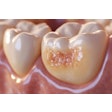
Direct composite buildups provide a high-quality, long-lasting approach to recontouring teeth and closing diastemas, according to a study in the Journal of Dentistry (December 2010, Vol. 38:12, pp. 1001-1009).
In a retrospective analysis of 327 composite buildups placed in 101 patients, members of the conservative dentistry department at the University of Heidelberg in Germany estimated the buildups' five-year survival rate to be 79.2%. Furthermore, the researchers found that more than 90% of the graded restorations were clinically excellent or clinically good.
Range of failure rates
The University of Heidelberg team, led by Diana Wolff, DDS, evaluated the survival and quality of the composite buildups placed by 13 dentists in the department between 2002 and 2008. The average follow-up time was 27.8 months, ranging from six to 71 months. Of the 178 patients in the study, 77 did not return for follow-up. Dr. Wolff and her colleagues assumed these individuals all had intact restorations because the work was guaranteed, with free repairs provided.
Most of the patients' teeth were treated with the composite system Enamel Plus HFO (Micerium). OptiBond FL primer and adhesive (KerrHawe) was used to bond all the restorations. The investigators did not have baseline quality information on the restorations and hence assumed they were all clinically excellent.
“Direct composite buildups have many advantages over more invasive and costly treatment options.”
— André Ritter, DDS, MS, University of
North Carolina
Enamel Plus HFO was associated with a 31.8% failure rate. Failure rates for the other systems range from 0% with Tetric (Ivoclar Vivadent) to 4.4% with Artemis (Ivoclar Vivadent) and 42.9% with Point 4 (Kerr).
The failure rates for each of the 13 participating dentists varied from 0% to 22.2%; the rate among the dentist who provided the most restorations (92) was 17.1%. The ranges in failure rates indicate that "the individual procedure of inserting the restoration as well as the properties of the material might have an influence on the survival of the restorations," the investigators noted in their report.
Forty-two of the teeth required repair, but only one completely lost its composite buildup, at 6.4 months, and hence was classified as a failure. The failure involved a deciduous mandibular right central incisor that the researchers' analysis showed had a major load during protrusion.
The main reason for repair was chipping of the composite resin (59.5%), while unsatisfactory color accounted for 14.3% of repairs, margin gaps for 11.9%, caries for 7.1%, unsatisfactory anatomic forms for 4.8%, and enamel fracture for 2.4%.
The remaining 284 restorations were classified as having survived. The investigators found the estimated five-year survival rate to be 79% (95% confidence interval, 70.5% to 87.9%).
They graded 26% of the restorations as being worse than clinically excellent using the modified U.S. Public Health Service/Ryge criteria, in one or more of these categories:
- Surface luster
- Anatomic form
- Fracture and retention
- Wear
- Patient's view
- Oral and general health
However, more than 90% were categorized as being overall clinically excellent or clinically good.
The team concluded that this approach provides "a beneficial relationship between minimal invasiveness, esthetic results, clinical effort, and longevity."
Well-designed study
While the German study has the limitations and weaknesses associated with this form of analysis, it is a very well-designed study, according to André Ritter, DDS, MS, an associate professor and graduate program director in the department of operative dentistry at the University of North Carolina School of Dentistry. "And retrospective, observational studies are valuable because they can provide insight into the performance of clinical techniques used under real-world conditions," he said.
"Direct composite buildups have many advantages over more invasive and costly treatment options such as porcelain veneers and full-coverage crowns," Dr. Ritter noted. "In these times of low economic activity, direct composite buildups can have an even greater positive impact on patients' smiles and clinicians' practices."
Copyright © 2010 DrBicuspid.com



















